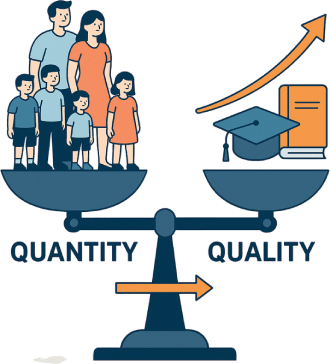Quantity–Quality Trade-off - Population Policy and Human Capital Investment
The relationship between human capital investment and population policy has been the central theme in economic development. The quantity-quality trade-off has been a rich source of this relationship. It is based on the premise that as family size increases, so does the amount of resources per child decrease. It then goes on to state that as resources are scarce, the quality of health and education that each household receives starts to deteriorate.
Understanding the Quantity-Quality Tradeoff

High-income nations of the modern era are featured by low human capital and high fertility, whereas high fertility and low human capital are relatively more prevalent in low-income countries. This difference is crucial in the context of the Quantity-Quality trade-off theory.
High fertility is customarily associated with poverty, even if the causal mechanism is yet to be established. Dad Gupta (1995) argued that poverty can be a determinant of high fertility rather than a result.
Whatever it is, it is the agreement among the majority of researchers that fertility decline can raise human capital per child. Consistent with Becker and Lewis' quantity-quality trade-off hypothesis, fewer children imply more investments per child and hence their overall quality improvement.
Galor and Weil's 2000 study emphasizes that accumulation of human capital is a key determinant of long-run economic growth. Governments are right to pursue policies to regulate population growth if the quantity-quality trade-off is valid. Such policies, designed to limit family size and raise investment in human capital, are especially relevant in developing nations, where low human capital is a constraint on economic progress.
However, these policies have their issues as well. They are not short-term in their impact, and they have to be put in place in the long term. China's one-child policy (OCP) is a natural experiment to see how population control policies influence human capital outcomes.
Effects of the One-Child Policy on Population Growth
The one-child policy was set up to restrain the population growth rate and promote the quality of China's population. The policy stressed "fewer children, higher population quality," in turn reducing fertility in China.
Studies have also shown a child quantity versus child quality trade-off in the country. This affirms that China's one-child policy heightened the human capital level of the next generation.
Li et al. 2008 also pointed out that the one-child policy's effect on human capital has helped improve China's economy in the last 10 years.
Population Policies and Their Effects

Policies affect population policies in different ways. Governments use policies to control the social consequences of population growth. Let's take a look at the implications of these population policies:
- Family planning initiatives: This is one of the most effective policies for the quantity-quality trade-off theory. Governments can create policies that make contraception and reproductive health services more available for citizens. This policy has worked in countries like Bangladesh and Indonesia.
- Public awareness programs: Public awareness programs that educate small-sized families help eradicate certain cultural practices. For example, policies that promote girls' education have been known to reduce early marriages and fertility rates.
- Incentive-based policies: Governments in some countries offer incentives to small families. These incentives, like conditional cash transfers, encourage families to send children to school or undergo maternal health check-ups. Countries like China use more coercive methods, like the one-child policy, to control population growth.
These policies have proven to be very effective in controlling population growth's social and demographic consequences.
Conclusion
Generally speaking, countries that are impoverished and underdeveloped are characterized by having high population growth rates. There is a possibility that there is no substantial evidence to demonstrate that poverty is caused by population expansion. Numerous studies, on the other hand, demonstrate that a high population growth rate has a detrimental impact on the economy.
In case you missed
You’re not in control of your decisions.
— Michael Anderson (@Slothenater) March 29, 2025
This Nobel Prize winner spent 37+ years proving it.
He exposed a psychological flaw in human decision-making.
Once you see it, you can’t unsee it.
And you'll question every decision you've ever made: 🧵 pic.twitter.com/z4AsEt8hYF

